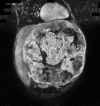The role of liver transplantation in the management of paediatric liver tumours
- PMID: 17316514
- PMCID: PMC1963524
- DOI: 10.1308/003588407X155527
The role of liver transplantation in the management of paediatric liver tumours
Abstract
In recent years, considerable progress has been made in the treatment of children with hepatoblastoma largely due to effective pre-operative chemotherapy. Total hepatectomy and liver transplantation has emerged as an effective treatment for the small proportion of children with unresectable hepatoblastoma limited to the liver. A 5-year survival of 70% can be achieved in such cases. In contrast, the results of liver transplantation in children with hepatocellular cancer remain poor because these tumours are usually advanced with evidence of major vascular invasion and/or extrahepatic spread at the time of presentation. An exception is those children in whom the hepatocellular carcinoma is detected during surveillance of chronic liver disease - they typically have smaller tumours and frequently have a good prognosis after liver transplantation. The role of liver transplantation in children with other primary hepatic malignancies remains uncertain because experience is very limited. Liver transplantation is rarely needed in the management of children with benign liver tumours but, if other treatments have failed, it can be a life-saving intervention.
Figures









Similar articles
-
Liver transplantation for malignant tumours in children.Eur J Pediatr Surg. 2006 Dec;16(6):411-4. doi: 10.1055/s-2006-924730. Eur J Pediatr Surg. 2006. PMID: 17211789
-
The contribution of transplantation to the treatment of liver tumors in children.Semin Pediatr Surg. 2005 Nov;14(4):233-8. doi: 10.1053/j.sempedsurg.2005.06.006. Semin Pediatr Surg. 2005. PMID: 16226698 Review.
-
Surgical treatment of hepatic tumors in children: lessons learned from liver transplantation.J Pediatr Surg. 2009 Nov;44(11):2083-7. doi: 10.1016/j.jpedsurg.2009.06.003. J Pediatr Surg. 2009. PMID: 19944212
-
Review of outcomes of primary liver cancers in children: our institutional experience with resection and transplantation.Surgery. 2010 Oct;148(4):778-82; discussion 782-4. doi: 10.1016/j.surg.2010.07.021. Epub 2010 Aug 21. Surgery. 2010. PMID: 20728194
-
Liver transplantation for malignancy.Oncologist. 2005 Apr;10(4):269-81. doi: 10.1634/theoncologist.10-4-269. Oncologist. 2005. PMID: 15821247 Review.
Cited by
-
Current therapeutic strategies for childhood hepatic tumors: surgical and interventional treatments for hepatoblastoma.Int J Clin Oncol. 2013 Dec;18(6):962-8. doi: 10.1007/s10147-013-0625-7. Epub 2013 Oct 17. Int J Clin Oncol. 2013. PMID: 24132546 Review.
-
Nested stromal epithelial tumor of the liver--liver transplantation and follow-up.J Gastrointest Cancer. 2011 Dec;42(4):292-5. doi: 10.1007/s12029-010-9248-7. J Gastrointest Cancer. 2011. PMID: 21221846
-
Orthotopic liver transplantation for Management of a Giant Liver Hemangioma: a case report and review of literature.BMC Surg. 2020 Jun 29;20(1):142. doi: 10.1186/s12893-020-00801-z. BMC Surg. 2020. PMID: 32600292 Free PMC article. Review.
-
PRETEXT II-III multifocal hepatoblastoma: significance of resection of satellite lesions irrespective of their disappearance after chemotherapy.Pediatr Surg Int. 2015 Jun;31(6):573-9. doi: 10.1007/s00383-015-3713-0. Epub 2015 Apr 23. Pediatr Surg Int. 2015. PMID: 25904441
-
The role of liver transplantation in the care of primary hepatic vascular tumours in children.Front Oncol. 2022 Nov 24;12:1026232. doi: 10.3389/fonc.2022.1026232. eCollection 2022. Front Oncol. 2022. PMID: 36505841 Free PMC article. Review.
References
-
- Mann JR, Kasthuri N, Raafat F, Pincott JR, Parkes SE, Muir KR, et al. Malignant hepatic tumours in children: incidence, clinical features and aetiology. Paediatr Perinat Epidemiol. 1990;4:276–89. - PubMed
-
- Brown J, Perilongo G, Shafford E, Keeling J, Pritchard J, Brock P, et al. Pretreatment prognostic factors for children with hepatoblastoma – results from the International Society of Paediatric Oncology (SIOP) study SIOPEL 1. Eur J Cancer. 2000;36:1418–25. - PubMed
-
- Pritchard J, Brown J, Shafford E, Perilongo G, Brock P, Dicks-Mireaux C, et al. Cisplatin, doxorubicin, and delayed surgery for childhood hepatoblastoma: a successful approach – results of the first prospective study of the International Society of Paediatric Oncology. J Clin Oncol. 2000;18:3819–28. - PubMed
-
- Perilongo G, Shafford E, Maibach R, Aronson D, Brugieres L, Brock P, et al. Risk-adapted treatment for childhood hepatoblastoma. final report of the second study of the International Society of Paediatric Oncology-SIOPEL 2. Eur J Cancer. 2004;40:411–21. - PubMed
-
- Glick RD, Nadler EP, Blumgart LH, LaQuaglia MP. Extended left hepatectomy (left hepatic trisegmentectomy) in childhood. J Pediatr Surg. 2000;35:303–8. - PubMed
Publication types
MeSH terms
LinkOut - more resources
Full Text Sources
Medical

